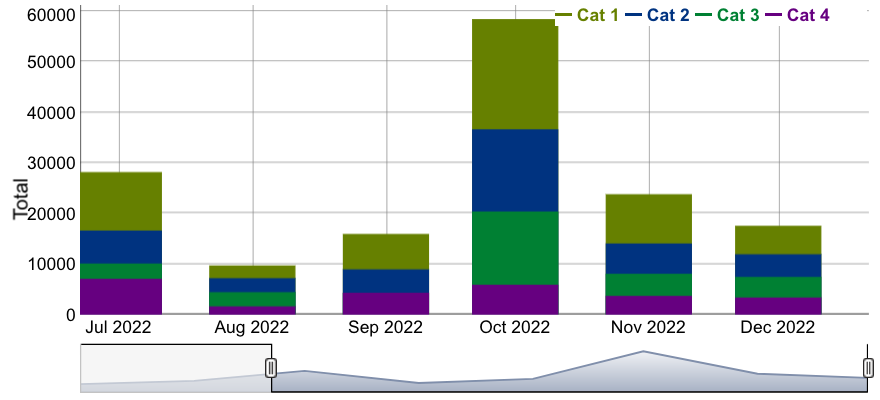I've got an xts df of the following format:
structure(c("May 2022", "Jun 2022", "Jul 2022", "Aug 2022", "Sep 2022",
"Oct 2022", "Nov 2022", "Dec 2022", " 3035.199", " 5500.000",
"11568.750", " 2510.000", " 6999.999", "21792.149", " 9750.000",
" 5624.999", " 2250.000", " 4136.975", " 6525.500", " 2771.875",
" 4637.500", "16273.499", " 6000.000", " 4494.649", " 2500.000",
" 0.000", " 3029.000", " 2803.500", " 0.000", "14481.250",
" 4374.998", " 4062.498", " 0.000", " 3075.000", " 6939.249",
" 1500.000", " 4183.157", " 5769.000", " 3559.500", " 3250.000"
), class = c("xts", "zoo"), index = structure(c(1651363200, 1654041600,
1656633600, 1659312000, 1661990400, 1664582400, 1667260800, 1669852800
), tzone = "UTC", tclass = "yearmon"), .Dim = c(8L, 5L), .Dimnames = list(
NULL, c("Month", "Cat 1", "Cat 2", "Cat 3", "Cat 4")))
I'm trying to create a stacked bar chart using the dygraphs library.
library(dygraphs)
library(lubridate)
today <- as.Date(Sys.time())
last_6 <- today+months(-6)
dygraph(df) %>%
dyAxis("y", label= "Total") %>%
dyRangeSelector(dateWindow = c(last_6, today)) %>%
dyMultiColumnGroup(c("Cat 1", "Cat 2", "Cat 3", "Cat 4"))
This produce a bar chart that looks like this:
I was wondering if anyone had any advice on how to make stacked bar chart? Many of the guides talk about bringing in plotters, but unfortunately they are not detailed enough for me to properly understand what is going on.
Adding this:
dyStackedBarGroup(c("Cat 1", "Cat 2", "Cat 3", "Cat 4"))
instead of the dyMultiColumnGroup line leads to a:
Error in cumulativeYval + points : non-numeric argument to binary operator



object 'last_6' not founderror when running data and code in question. Do you get this when running the question in a fresh version of R? – Conformable